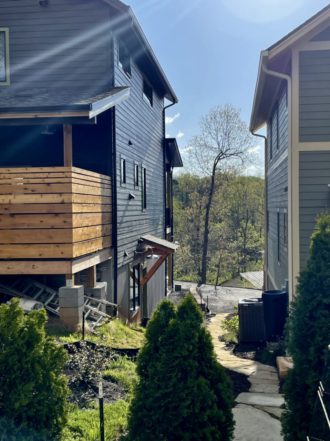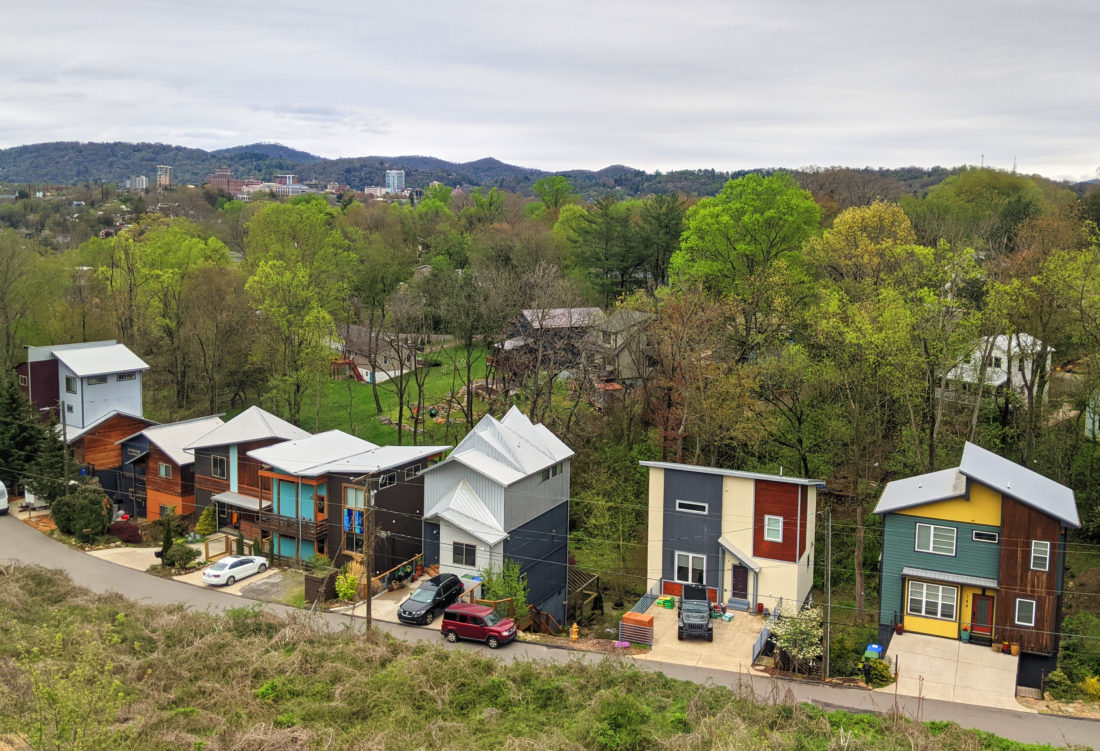Earlier this month, a Reddit user posted a photo of a row of houses on Waynesville Avenue in West Asheville. Accompanying the shot was a simple question: “What style is this?”
In response to the tall, skinny homes, each a hodgepodge of colors and materials built on a sharp slope, members of Reddit’s architecture forum quickly replied with suggestions both thoughtful (Postmodern, Contractor Contemporary, Modern Vernacular, Deconstructivist, a mixture of ’70s Shed and Contemporary) and sarcastic (Favela Expressionist, Casa Cerdo, Schweinhaus, Asheville Yupster Modern, Construction Site Surplus).
Whatever one calls it, this style of home has become increasingly popular in West Asheville over the past few years. It’s a solution to maximize square footage on small lots in a desirable part of town, where available land grows scarcer by the day. But while some community members see these structures as an affordable means of putting down roots in a neighborhood they love, others view the additions as eyesores with wide-ranging negative implications.
Signs of the times
W. Smith McAulay, president and lead designer for Asheville-based contractor WSM Craft and a West Asheville resident from 2002-18, refers to these houses as “urban infill.” Their materials and styling tend toward Modern/Contemporary with varying degrees of elegance and creativity, he says, but they are guided by the lots on which they are built. He notes that the style has emerged over the past decade or so as the property supply has thinned out.
“I remember when the Riverside Drive stilt houses went up in about 2006. They’re just Craftsman bungalows, so you don’t have the emergence of the style yet. But you do have a substantial commitment to engineer a solution to all of that ‘unbuildable’ space right here in town,” McAulay says.
“Just about the only lots left in West Asheville are the kudzu canyons that have been considered unbuildable for a long time,” he continues. “They are, in fact, buildable, but the only option is a small footprint — in some cases a substantial lower level just to get the main floor up to street level.”
Overall, McAulay considers urban density along the river corridor a good thing. Not only have these additions created housing out of challenging terrain rather than by destroying pristine woodlands, he says, but the demand to build on these lots has resulted in graders, concrete technicians, block masons and other subcontractors becoming accustomed to the challenging conditions.
In general, McAulay likes the modern lines of urban infill houses and their tendency toward creative use of materials. He applauds the shabby-chic element in the best examples, saying it aligns with numerous businesses in the greater West Asheville/River Arts District area that are outfitted in a similar spirit.
Here to stay
When considering whether the style will age well, McAulay believes it will define the current West Asheville renaissance in a similar way that neighborhoods like Montford or Kenilworth are reference points for specific eras in Asheville’s history, shaped by the economy and available workforce at that time.
Over the next few years, he sees the current boom squeezing the last available lots out of West Asheville. More forgettable homes in the area, he suggests, will be torn down to free up lots for new builds that will inevitably piggyback the infill style, even without lot constraints.
“Most are built on block foundations, which are far superior to the brick-on-clay foundations of the cherished West Asheville bungalows from the ’20s. And most are framed with the ZIP sheathing system, with engineered trusses or joists for floors and roofs, which is a tight and uniform method of framing,” McAulay says of the style’s advantages. “Most also have metal roofs and cementitious lap siding or metal roofing for siding, which will essentially last forever. And most are certified Green Built [through Asheville-based nonprofit Green Built Alliance] and/or Energy Star certified because the market demands it. So, yes, they are built to last.”
Though he notes that housing affordability is another conversation altogether, McAulay says demand for homes in West Asheville is “through the roof” and that people are willing to pay high prices for the active, urban, pedestrian lifestyle that this part of town offers. In turn, those desires are also shaping the type of people who live in these houses, and he feels they’ll continue to do so for the foreseeable future.
“The market is asking for comfortable, stylish accommodations for young families, young professionals and the young at heart,” he says. “They’ll either grow old there or they’ll be replaced by new youngsters who’ll put their own mark on the houses as they continue to renovate and innovate.”
Neighborhood debate
The opinions of West Asheville homeowners on urban infill houses, like the structures themselves, are more varied. Longtime resident Wendi Williams refers to the style as “glorified chicken coops” and feels that structures resembling old industrial buildings visually clash with surrounding homes. The amount of stairs common in these designs, she adds, makes aging in place impractical without adding a costly elevator.
Beyond aesthetic concerns and the suitability of the homes for future West Asheville residents, Williams says new homes often create environmental issues. She has witnessed builders disregard trees, leading to what she calls “the raping and pillaging of our once splendid canopy,” as well as significant increases in erosion and runoff.

Meanwhile, though fellow neighborhood mainstay Jeannie Lindsay is generally fond of the style and the way its houses incorporate land conservation and energy efficiency elements, she says they can feel crowding in old neighborhoods. “If you live in a tiny 1925 house (we do) and they start popping up right next to you all over the place (they have), they loom over your house, throw shade on your solar panels, and since there isn’t enough yard around the homes for, say, trees, they’re staring right into all your windows,” she explains.
Among people who actually own these kinds of homes, many are both happy to be in stable housing in a desirable area and pleased with the urban infill style. Tessa and Andy Paul doubted that they’d ever be in a financial position to build a house, especially in West Asheville, where they wanted to live long-term. But through local affordable builders Compact Cottages, the Pauls achieved that dream on State Street for less than $300,000.
“It’s not that we were looking to build in a certain style. We needed a house,” Andy Paul says. “That said, I’m all about shaking things up in terms of aesthetics and architecture, so I love the fact that our house is in this style and that it’s something different.”
Though the homes are tall and skinny, the LP SmartSide siding, made from a treated engineered wood product, is distinct from the metal roofing siding on some similar West Asheville houses. And while frequent stair usage is a necessity, the Pauls quickly adjusted — part of a situation they say they knew they were getting into with a company whose name is upfront about its product.
Regarding neighborhood pushback, Paul notes that many architectural styles were initially loathed, including the now-iconic brownstones in New York City’s Manhattan and Greenwich Village. He suggests that many Asheville residents want the city to stay the way it was when they arrived — a phenomenon he also observed from multiple generations while living in Austin, Texas, in the early 2000s.
Scott Adams, who also built a Compact Cottages house in West Asheville with his wife, Erin, for roughly $370,000, understands why people with houses built in the 1920s get upset when something new and different is built across the street. But he believes the desire to freeze time is doubly implausible when a modest new-build house frequently costs less and is a better long-term investment than a much older home in need of significant repairs.
“It’s kind of like the analogy of, if you got a puppy, would you be surprised or angry if it turned into a dog 10 years later?” Adams says. “City neighborhoods change over time. It’s the whole conundrum of, just because you’ve always lived in the neighborhood, do you get to dictate who else gets to live there and how it looks over time?”
While Adams’ property features a city-mandated 30-foot buffer from a neighboring stream and a silt fence to help reduce erosion, he plans to plant new trees and add multiple raised-bed gardens on the slope by his house. He sees himself carrying on the tradition of those 1920s homeowners who likewise cleared West Asheville lots to build their houses — around which new oaks and maples grew to shade those who live there today.




Thoughtful, well-written, informative, and timely article. Thanks.
Thank you!
Go to any location where real estate is at a premium: NY, Tokyo, Aspen. Narrow and tall is how things are built. This is all part of Asheville’s transformation into one of the most unaffordable locales in the world. Climate change is only exacerbating this process.
Climate ‘change’ is the biggest hoax ever foisted upon us … it’s bullshite.
Yes I agree “Climate Change ” is just a HOAX !!! The real deal is “GLOBAL WARMING ” ! ! !